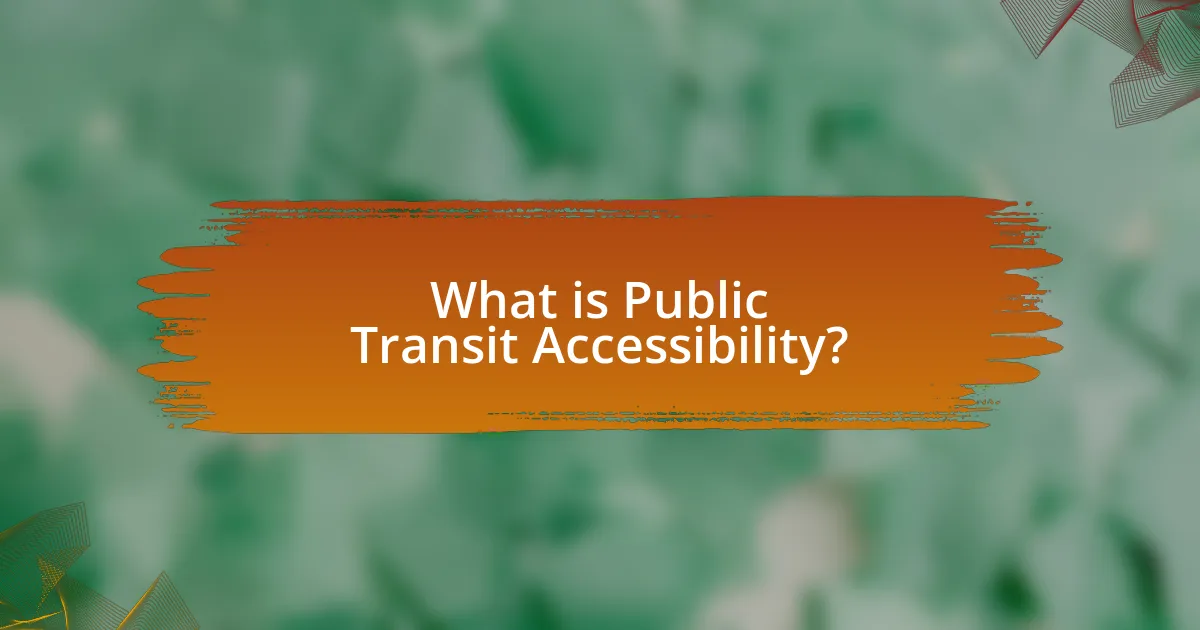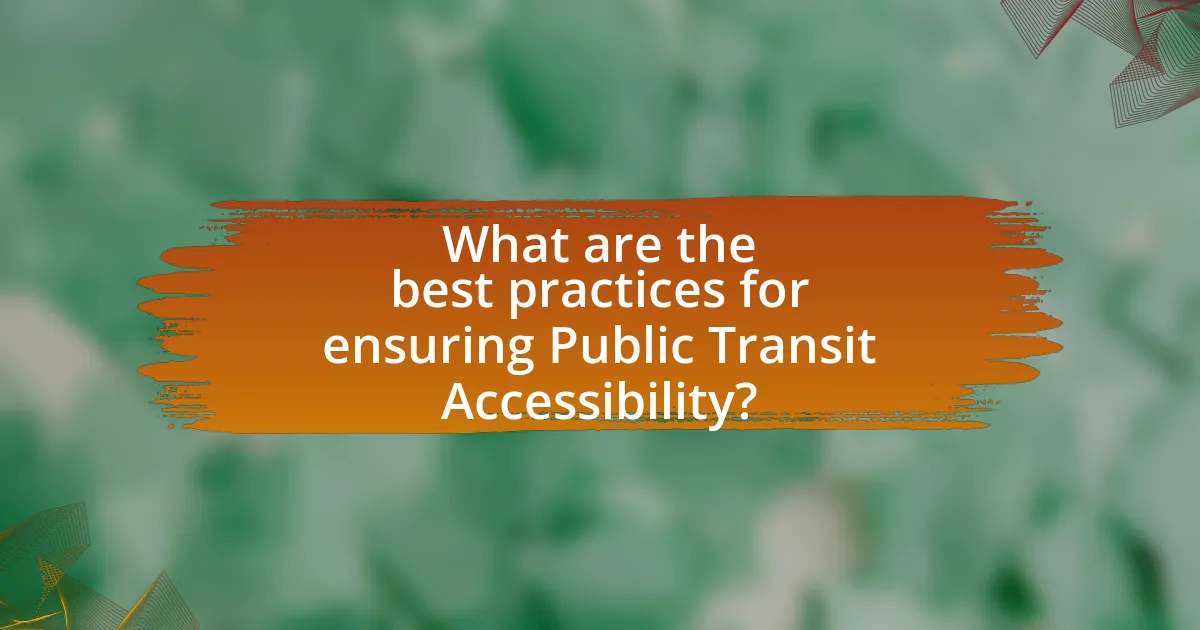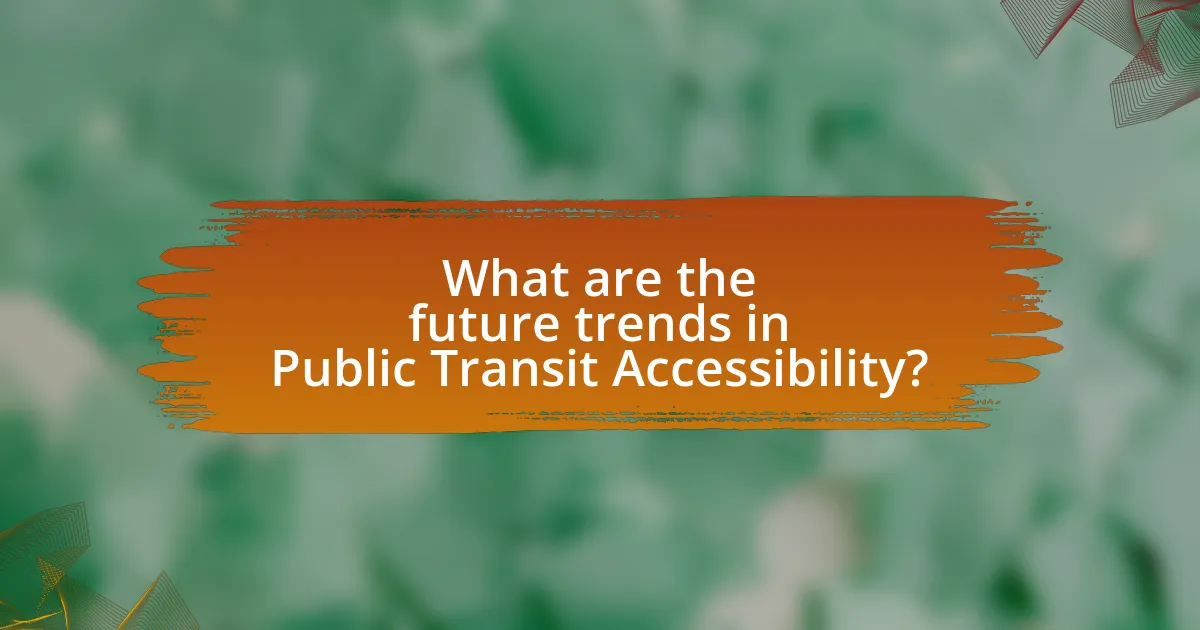Public transit accessibility is the design and implementation of transportation systems that ensure all individuals, including those with disabilities, the elderly, and marginalized groups, can effectively use public transit services. The article outlines the definition of public transit accessibility, its key components such as physical access, information accessibility, affordability, and service availability, and the importance of these features for community inclusion and economic growth. It also discusses the diverse populations impacted by accessibility, the challenges faced in achieving it, and strategies for improvement, including the role of technology and community engagement. Additionally, the article highlights relevant policies and future trends that aim to enhance public transit accessibility for all users.

What is Public Transit Accessibility?
Public transit accessibility refers to the design and implementation of transportation systems that ensure all individuals, including those with disabilities, the elderly, and other marginalized groups, can use public transit services effectively. This concept encompasses features such as wheelchair ramps, audio and visual aids, and accessible routes that facilitate ease of use for everyone. According to the Americans with Disabilities Act (ADA), public transit systems must provide equal access to services, which has led to significant improvements in accessibility features across various transit agencies.
How is Public Transit Accessibility defined?
Public transit accessibility is defined as the degree to which transportation systems are designed to be usable by all individuals, including those with disabilities, the elderly, and other marginalized groups. This definition encompasses features such as wheelchair ramps, audible announcements, and accessible information systems, which facilitate equal access to public transportation services. According to the Americans with Disabilities Act (ADA), public transit must provide services that are accessible to individuals with disabilities, ensuring that they can navigate the transit system effectively and independently.
What are the key components of Public Transit Accessibility?
The key components of public transit accessibility include physical access, information accessibility, affordability, and service availability. Physical access ensures that transit facilities and vehicles are designed to accommodate individuals with disabilities, featuring ramps, elevators, and designated seating. Information accessibility involves providing clear, understandable information about transit services, schedules, and routes in multiple formats, including visual and auditory aids. Affordability ensures that transit fares are within reach for all users, including low-income populations. Service availability refers to the frequency and coverage of transit routes, ensuring that services meet the needs of diverse communities, including those in underserved areas. These components collectively enhance the usability of public transit for all individuals, promoting inclusivity and mobility.
Why is Public Transit Accessibility important for communities?
Public transit accessibility is crucial for communities because it ensures that all individuals, regardless of their physical abilities or socioeconomic status, can access essential services and opportunities. Accessible public transit promotes social inclusion, allowing people to participate in the workforce, education, and community activities. According to the American Public Transportation Association, communities with accessible transit systems experience increased economic growth, as they enable a larger workforce to reach jobs and businesses to attract customers. Furthermore, studies show that improved transit accessibility can lead to reduced traffic congestion and lower environmental impact, benefiting the entire community.
Who benefits from Public Transit Accessibility?
Individuals with disabilities, low-income populations, and the elderly benefit from public transit accessibility. Public transit systems designed with accessibility features enable these groups to access essential services, employment opportunities, and social activities. For instance, the American Public Transportation Association reports that accessible transit options significantly improve mobility for people with disabilities, allowing them to participate more fully in their communities. Additionally, low-income individuals often rely on public transit as their primary means of transportation, making accessibility crucial for their economic stability and social inclusion.
What diverse populations are impacted by Public Transit Accessibility?
Public transit accessibility impacts various diverse populations, including individuals with disabilities, low-income communities, the elderly, and racial and ethnic minorities. Individuals with disabilities often face physical barriers that limit their access to transit services, while low-income communities may rely heavily on public transportation for employment and essential services. The elderly population frequently requires accessible transit options to maintain independence and mobility. Racial and ethnic minorities may experience disparities in transit access due to systemic inequities. According to the American Public Transportation Association, nearly 25% of public transit users are people with disabilities, highlighting the critical need for accessible transit solutions.
How does Public Transit Accessibility support individuals with disabilities?
Public transit accessibility supports individuals with disabilities by providing them with equitable access to transportation services, enabling independence and participation in community activities. Accessible public transit systems include features such as low-floor buses, elevators in train stations, and audio-visual announcements, which facilitate easier boarding and navigation for individuals with mobility, visual, or hearing impairments. According to the Federal Transit Administration, accessible transit options can significantly enhance the quality of life for individuals with disabilities by reducing barriers to employment, education, and social engagement.
What challenges exist in achieving Public Transit Accessibility?
Achieving public transit accessibility faces several challenges, including inadequate infrastructure, insufficient funding, and lack of awareness among transit authorities. Inadequate infrastructure often results in physical barriers such as stairs without ramps, poorly designed bus stops, and inaccessible vehicles, which hinder individuals with disabilities from using public transit effectively. Insufficient funding limits the ability of transit agencies to implement necessary upgrades and maintain accessible services. Furthermore, a lack of awareness among transit authorities about the specific needs of diverse populations can lead to the neglect of essential features like audio announcements and visual aids, which are crucial for individuals with sensory impairments. These challenges collectively impede the goal of creating an inclusive public transit system.
What are the common barriers faced by diverse populations in public transit?
Diverse populations face several common barriers in public transit, including physical accessibility issues, lack of information, and affordability challenges. Physical accessibility issues often arise from inadequate infrastructure, such as the absence of ramps or elevators, which disproportionately affects individuals with disabilities. A study by the National Council on Disability in 2019 highlighted that 70% of public transit systems in the U.S. do not fully comply with accessibility standards. Lack of information manifests in limited availability of multilingual resources and real-time updates, making it difficult for non-native speakers and those with varying literacy levels to navigate transit systems effectively. Additionally, affordability challenges arise as low-income individuals may struggle to cover transit costs, with a report from the American Public Transportation Association indicating that 45% of low-income households spend more than 20% of their income on transportation. These barriers collectively hinder equitable access to public transit for diverse populations.
How do socioeconomic factors influence Public Transit Accessibility?
Socioeconomic factors significantly influence public transit accessibility by determining the availability, affordability, and quality of transit services. Individuals from lower socioeconomic backgrounds often face barriers such as limited financial resources, which restrict their ability to afford transit fares or access reliable transportation options. For instance, a study by the American Public Transportation Association found that households earning less than $25,000 annually are more likely to rely on public transit, highlighting the critical role of affordability in accessibility. Additionally, socioeconomic status affects geographic location, with low-income communities frequently situated in areas with fewer transit routes and services, further limiting their access to essential destinations like jobs and healthcare.
How can we improve Public Transit Accessibility?
To improve public transit accessibility, cities should implement universal design principles that ensure all transit systems accommodate diverse populations, including individuals with disabilities. This can be achieved by retrofitting existing infrastructure with features such as low-floor buses, audible announcements, and tactile guidance systems. According to the American Public Transportation Association, accessible transit options can increase ridership by up to 30% among people with disabilities, demonstrating the effectiveness of these improvements. Additionally, training staff on accessibility awareness and providing real-time information through mobile apps can further enhance the user experience for all passengers.
What strategies can be implemented to enhance accessibility in public transit systems?
To enhance accessibility in public transit systems, implementing universal design principles is essential. Universal design involves creating transit environments that accommodate all users, including those with disabilities, the elderly, and families with children. Specific strategies include installing low-floor buses and accessible train cars to facilitate easier boarding, providing real-time information through multiple formats (such as audio and visual displays), and ensuring that transit stations have ramps, elevators, and tactile guidance systems. According to the American Public Transportation Association, systems that adopt these strategies can significantly improve ridership among people with disabilities, as evidenced by a 2019 report showing a 30% increase in usage when accessibility features are enhanced.
How can technology play a role in improving Public Transit Accessibility?
Technology can significantly improve public transit accessibility by providing real-time information, enhancing communication, and enabling adaptive services. For instance, mobile applications that offer real-time tracking of buses and trains allow users to plan their journeys more effectively, reducing wait times and uncertainty. Additionally, features like audio announcements and visual displays on vehicles and at stations cater to individuals with visual and hearing impairments, ensuring they receive essential information. Furthermore, data analytics can identify patterns in transit usage, allowing agencies to adjust routes and schedules to better serve underserved communities. According to a study by the American Public Transportation Association, the integration of technology in transit systems has led to increased ridership and satisfaction among users, demonstrating its effectiveness in enhancing accessibility.

What are the best practices for ensuring Public Transit Accessibility?
Best practices for ensuring public transit accessibility include implementing universal design principles, providing comprehensive training for staff, and engaging with the community to understand diverse needs. Universal design principles ensure that transit systems are usable by all individuals, regardless of ability, by incorporating features such as low-floor buses, audible announcements, and tactile guidance systems. Training for staff is crucial, as it equips them to assist passengers with disabilities effectively, enhancing the overall experience. Engaging with the community allows transit authorities to gather feedback and make informed decisions that reflect the needs of various populations, ensuring that services are inclusive and accessible.
How can transit agencies engage with diverse communities?
Transit agencies can engage with diverse communities by implementing targeted outreach programs that include multilingual communication, community workshops, and partnerships with local organizations. These strategies ensure that transit information is accessible and relevant to various cultural and linguistic groups. For instance, a study by the American Public Transportation Association found that agencies that actively involve community members in planning processes see a 30% increase in ridership among underrepresented populations. This demonstrates that effective engagement leads to improved service utilization and satisfaction among diverse communities.
What methods can be used to gather feedback from users about accessibility needs?
Surveys and interviews are effective methods to gather feedback from users about accessibility needs. Surveys can be distributed online or in-person, allowing users to provide structured feedback on their experiences and challenges with public transit accessibility. Interviews offer a more in-depth understanding of individual needs and can uncover specific barriers faced by users. Research indicates that user feedback collected through these methods can lead to improved accessibility features and services, as seen in studies conducted by the Transportation Research Board, which highlight the importance of user input in enhancing public transit systems.
How can partnerships with local organizations enhance accessibility efforts?
Partnerships with local organizations can enhance accessibility efforts by leveraging community knowledge and resources to identify and address specific barriers faced by diverse populations. Local organizations often have established relationships with the communities they serve, allowing them to gather insights on accessibility challenges and advocate for tailored solutions. For instance, a study by the American Public Transportation Association found that transit agencies collaborating with local disability advocacy groups improved service design and outreach, resulting in a 30% increase in ridership among individuals with disabilities. This collaboration ensures that accessibility initiatives are not only effective but also aligned with the actual needs of the community, thereby fostering inclusivity in public transit systems.
What policies support Public Transit Accessibility?
Policies that support public transit accessibility include the Americans with Disabilities Act (ADA), which mandates accessible public transportation systems for individuals with disabilities. The ADA requires transit agencies to provide accessible vehicles, facilities, and services, ensuring that people with mobility challenges can use public transit effectively. Additionally, the Federal Transit Administration (FTA) provides funding and guidelines for transit agencies to enhance accessibility features, such as low-floor buses and accessible stations. These policies collectively aim to create an inclusive transit environment that meets the diverse needs of all populations.
What legislation exists to promote accessibility in public transit?
The Americans with Disabilities Act (ADA) is the primary legislation promoting accessibility in public transit. Enacted in 1990, the ADA mandates that all public transportation systems must be accessible to individuals with disabilities, ensuring features such as wheelchair ramps, accessible seating, and audible announcements. Additionally, the ADA requires that new transit vehicles and facilities be designed to accommodate individuals with various disabilities, thereby enhancing their mobility and independence. The Federal Transit Administration (FTA) oversees compliance with these regulations, providing guidelines and funding to support accessible transit initiatives.
How do funding mechanisms impact the implementation of accessibility measures?
Funding mechanisms significantly influence the implementation of accessibility measures by determining the availability of financial resources necessary for such initiatives. When funding is allocated specifically for accessibility projects, it enables transit agencies to invest in infrastructure improvements, technology upgrades, and staff training aimed at enhancing accessibility for diverse populations. For instance, the Federal Transit Administration’s Section 5310 program provides funding specifically for transportation services for individuals with disabilities, which directly supports the development of accessible transit options. Conversely, inadequate or poorly structured funding can lead to delays or the complete absence of necessary accessibility measures, as seen in various studies indicating that financial constraints are a primary barrier to implementing effective accessibility solutions in public transit systems.

What are the future trends in Public Transit Accessibility?
Future trends in public transit accessibility include the integration of smart technology, enhanced mobility options, and a focus on inclusive design. Smart technology, such as real-time tracking and mobile applications, will improve user experience by providing timely information and facilitating easier navigation for all passengers. Enhanced mobility options, including on-demand transit services and micro-mobility solutions like e-scooters, will cater to diverse needs, particularly for individuals with disabilities or those in underserved areas. Additionally, inclusive design principles will be increasingly adopted, ensuring that transit systems are built to accommodate various physical and cognitive abilities, as evidenced by initiatives like the Americans with Disabilities Act, which has driven improvements in accessibility standards since its enactment in 1990.
How is the landscape of Public Transit Accessibility evolving?
The landscape of Public Transit Accessibility is evolving through increased integration of technology, improved infrastructure, and a focus on inclusivity for diverse populations. Transit agencies are adopting real-time tracking apps and automated systems to enhance user experience, making it easier for individuals with disabilities to navigate public transport. For instance, the Federal Transit Administration reported that as of 2022, over 80% of public transit agencies in the U.S. have implemented some form of accessibility technology. Additionally, cities are investing in accessible vehicles and infrastructure, such as low-floor buses and tactile paving, to accommodate various needs. This evolution reflects a broader commitment to ensuring equitable access to public transit for all community members.
What role does urban planning play in shaping accessible transit systems?
Urban planning plays a crucial role in shaping accessible transit systems by integrating transportation infrastructure with land use and community needs. Effective urban planning ensures that transit routes are strategically located to serve diverse populations, including those with disabilities, the elderly, and low-income individuals. For instance, cities that prioritize mixed-use developments and high-density housing near transit hubs facilitate easier access to public transportation. Research from the American Public Transportation Association indicates that well-planned transit systems can increase ridership by up to 30%, demonstrating the impact of thoughtful urban design on accessibility.
How can sustainability initiatives intersect with Public Transit Accessibility?
Sustainability initiatives can enhance public transit accessibility by promoting eco-friendly transportation options that are designed to be inclusive for all users. For instance, integrating electric buses into public transit systems reduces carbon emissions while providing accessible features such as low floors and designated spaces for individuals with disabilities. Research from the American Public Transportation Association indicates that investments in sustainable transit options can lead to a 45% increase in ridership among diverse populations, thereby improving overall accessibility. Additionally, sustainable urban planning that prioritizes transit-oriented development ensures that public transit routes are strategically located near underserved communities, further bridging the gap in accessibility.
What practical steps can individuals take to advocate for Public Transit Accessibility?
Individuals can advocate for public transit accessibility by engaging in community organizing, participating in public meetings, and collaborating with local advocacy groups. Community organizing involves mobilizing residents to collectively voice their needs and concerns regarding transit accessibility, which can lead to increased awareness among decision-makers. Attending public meetings allows individuals to directly communicate with transit authorities and local government officials, presenting specific accessibility issues and proposing solutions. Collaborating with advocacy groups, such as disability rights organizations, can amplify efforts by providing resources, expertise, and a broader platform to influence policy changes. These actions are supported by studies indicating that grassroots advocacy significantly impacts public policy, as seen in the successful campaigns for accessible transit systems in cities like San Francisco and New York.
How can community members effectively voice their accessibility concerns?
Community members can effectively voice their accessibility concerns by participating in public forums, submitting written feedback to transit authorities, and engaging in advocacy groups focused on accessibility issues. Public forums allow individuals to share their experiences and suggestions directly with decision-makers, while written feedback provides a documented record of concerns that can be reviewed by transit officials. Advocacy groups often amplify individual voices, creating a collective impact that can lead to policy changes. Research indicates that community engagement in transit planning significantly improves service accessibility, as seen in studies conducted by the Transportation Research Board, which highlight the importance of stakeholder input in enhancing public transit systems.
What resources are available for individuals seeking to improve transit accessibility in their area?
Individuals seeking to improve transit accessibility in their area can utilize resources such as local advocacy groups, government transportation departments, and community planning organizations. Local advocacy groups often provide information on accessibility issues and can mobilize community support for improvements. Government transportation departments typically offer programs and funding opportunities aimed at enhancing public transit accessibility, including grants for infrastructure upgrades. Community planning organizations may conduct studies and provide data on transit needs, helping to inform policy changes and improvements. For example, the Federal Transit Administration offers resources and guidelines for enhancing accessibility in public transit systems, which can be leveraged by individuals and organizations working towards this goal.


